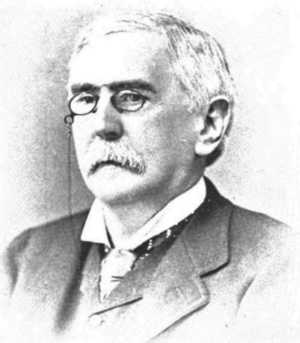Mathew Carey Lea facts for kids
Quick facts for kids
Mathew Carey Lea
|
|
|---|---|
 |
|
| Born | August 18, 1823 |
| Died | March 15, 1897 (aged 73) Philadelphia, Pennsylvania, U.S.
|
| Burial place | Laurel Hill Cemetery, Philadelphia, Pennsylvania, U.S. |
| Occupation | Chemist, lawyer |
| Spouse(s) |
Elizabeth Jaudon
(m. 1852; died 1881)
|
| Relatives | Isaac Lea (father) Frances Anne Carey (mother) Henry Charles Lea (brother) Henry Charles Carey (uncle) Matthew Carey (grandfather) |
| Signature | |
 |
|
Mathew Carey Lea (born August 18, 1823 – died March 15, 1897) was an American chemist. He was famous for his studies on silver halide salts, which are chemicals used in photography. He also helped start a new science called mechanochemistry and created a special chemical called Carey Lea Silver, which is still used today.
Early Life and Learning
Mathew Carey Lea was born in Philadelphia on August 16, 1823. His father, Isaac Lea, was a publisher and also studied shells and rocks. His grandfather, Mathew Carey, was a well-known publisher and economist.
Mathew was taught at home by private teachers. One of his teachers was the mathematician Eugenius Nulty. He learned many subjects, including grammar, logic, math, and history. His teachers encouraged him to focus deeply on one subject at a time. He also learned about chemistry in a private lab.
In 1852, Mathew married Elizabeth Jaudon. They had a son named George Henry Lea. George later helped with the family's publishing business. After Elizabeth passed away, Mathew married Eva Lovering.
His Career and Discoveries
Mathew Lea became very interested in photography. In 1840, he took pictures of his father's plant and shell collections. These pictures were shown at the American Philosophical Society.
He also studied law and became a lawyer in 1847. However, he often felt sick. Because of his health, he stopped practicing law and traveled to Europe. He wanted to focus on his scientific interests.
Lea built a chemistry lab in his home in Philadelphia. In 1841, he published his first science paper. Over his life, he published about 100 more papers in the American Journal of Science and Arts. He also wrote about platinum.
Mathew Lea spent most of his time studying the chemistry of photography. He made many important discoveries in this area. People recognized him as an expert on silver halide salts and how they are used in photography. He wrote over 300 articles and a book called A Manual of Photography.
He also studied how light affects chemicals, a process called chemical action of light. He is well-known for creating Carey Lea Silver, a special chemical still used in photography today.
Mathew Lea lost an eye during a science experiment. Because of this and his ongoing health problems, he spent most of his time alone. He did not work at any universities. His main way of connecting with other scientists was by publishing his research.
In 1848, he joined the Franklin Institute, a place for science and education. In 1895, he was chosen to be a member of the National Academy of Sciences.
Later Life and Impact
Mathew Lea passed away on March 15, 1897, at his home. He was buried in Laurel Hill Cemetery in Philadelphia. Before he died, he asked for his science notebooks to be destroyed. This has made it harder for people to study his work today.
He gave his books and science equipment to the Franklin Institute. He also left money so they could keep buying new books and magazines. Mathew Lea's work in mechanochemistry was very important, even more so than his photography work, which he was famous for during his lifetime.

